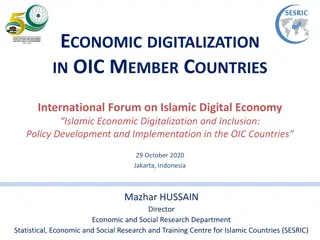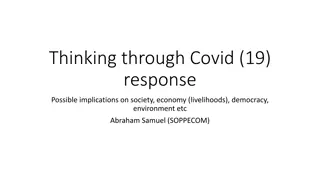Leveraging Digital Infrastructure for Effective COVID-19 Response
Discover how the development of environmental health engineering facilities, equipment, sensors, and public health systems is crucial in combating COVID-19. Explore the importance of strengthening digital infrastructure, integrating AI in the response, and utilizing surveillance tools. Learn about the role of AI in predicting outbreaks and supporting medical evaluations. Witness the global changes in online services, internet requirements, and industry connectivity amidst the pandemic.
Download Presentation

Please find below an Image/Link to download the presentation.
The content on the website is provided AS IS for your information and personal use only. It may not be sold, licensed, or shared on other websites without obtaining consent from the author. Download presentation by click this link. If you encounter any issues during the download, it is possible that the publisher has removed the file from their server.
E N D
Presentation Transcript
DEVELOPMENT OF ENVIRONMENTAL HEALTH ENGINEERING FACILITIES, EQUIPMENT, SENSORS AND PUBLIC HEALTH SYSTEMS FOR TACKLING COVID-19
INTRODUCTION In January 2020 the World Health Organization (WHO) declared the outbreak of a new coronavirus disease, COVID-19, to be a Public Health Emergency of International Concern. WHO stated that there is a high risk of COVID-19 spreading to other countries around the world. In March 2020, WHO made the assessment that COVID-19 can be characterized as a pandemic. WHO and public health authorities around the world are acting to contain the COVID-19 outbreak. However, this time of crisis is generating stress throughout the population. The considerations presented in this document have been developed by the WHO Department of Mental Health and Substance Use as a series of messages that can be used in communications to support mental and psychosocial well-being in different target groups during the outbreak.
Our digital infrastructure needs strengthening to deal with the impact of COVID-19 and future public health crises; Better integration of Artificial Intelligence in to the public health response should be a priority; Analysis of big data relating to citizens' movement, disease transmission patters and health monitoring could be used to aid prevention measures.
Governments are now relying on ubiquitous instruments (sensors) and powerful algorithms instead of flesh-and-blood spooks. In the war against COVID-19, several governments have implemented these new surveillance tools.
Digital infrastructure plays a pivotal role in predicting and modelling outbreaks. Take AI-supported services for a lung CT scan: the AI is premeditated to quickly detect lesions of likely coronavirus pneumonia; to measure its volume, shape and density; and to compare changes of multiple lung lesions from the image. This provides a quantitative report to assist doctors in making fast judgements and thus helps expedite the health evaluation of patients.
In the ongoing covid-19 pandemic, we are witnessing three major occurrences across the globe: 1. Wider acceptance of online services; 2. A humongous requirement for internet services for conventional industries; 3. Boosted connectivity among diverse types of industries.
What you can do now: Develop incident management and scenario plans that are specific to this crisis Focus on factually and effectively communicating to stakeholders Plan on how to meet government priorities in individual countries and minimise the risk of business disruptions

















































